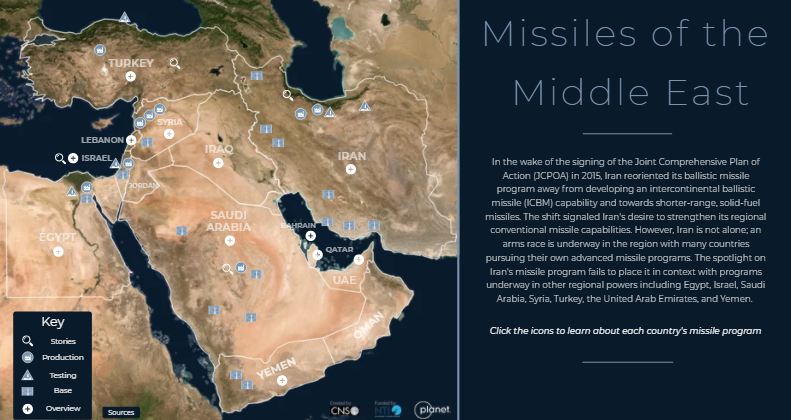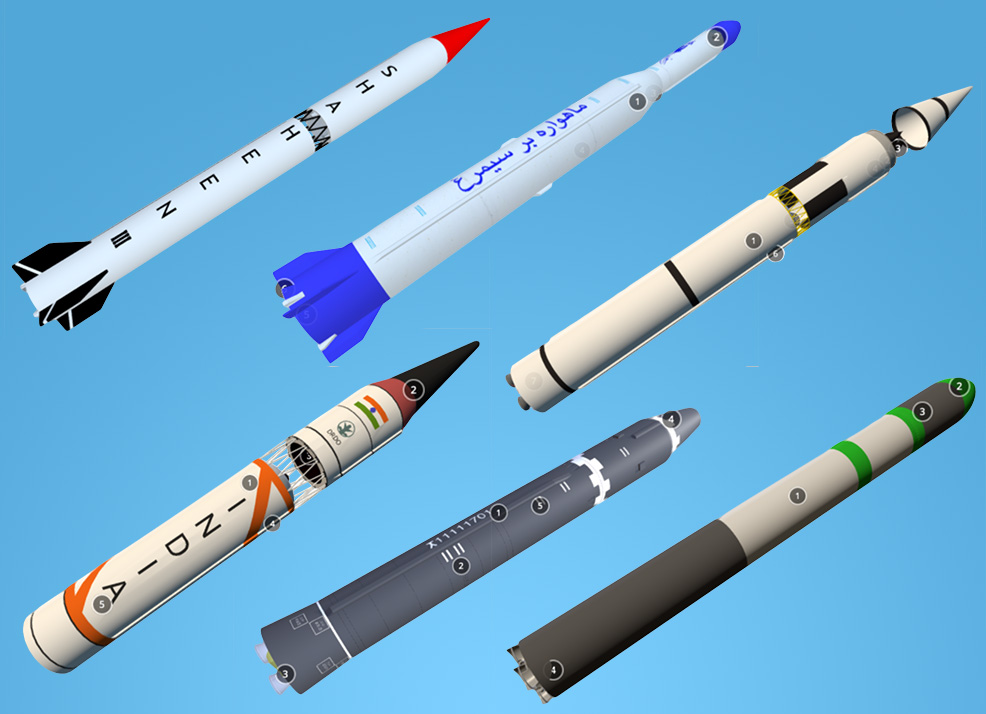
Shea Cotton
Senior Research Associate, The James Martin Center for Nonproliferation Studies
In the wake of North Korea’s second successful intercontinental ballistic missile (ICBM) test, it is clear that the specter of a North Korean nuclear threat to the U.S. homeland is now a credible reality. North Korea epitomizes an illicit nuclear and missile program unchecked by diplomatic limits, pursued by a country that sees itself as having nothing to lose. This could have been Iran. It still could be if the international community fails to see how much the Iran nuclear deal has changed the course of the country’s missile program, and this despite the fact that the deal does not officially limit Iran’s missiles.
Since negotiation and implementation of the Joint Comprehensive Plan of Action (JCPOA), Iran has altered its missile testing patterns, decreasing overall numbers of tests and focusing on solid-fueled short-range missile capabilities rather than an ICBM. Although the JCPOA does not place limits on Iranian missile testing, many Western analysts have accused Iran of violating the spirit of the deal by continuing to test missiles and space launch vehicles (SLVs).
The James Martin Center for Nonproliferation Studies (CNS) has created a new comprehensive database of Iranian missile and SLV tests and operational launches since the end of the Iran-Iraq War. The data strongly suggests that the JCPOA has helped redirect Iran’s priorities for its missile program away from developing an ICBM (whose only purpose would be as a nuclear delivery system), to developing solid-fueled versions of its short-range missiles. While such missiles could also be nuclear-capable, they do not extend Iran’s range or payload capabilities meaningfully, and appear intended to serve a conventional purpose. This is consistent with the existential rationale of Iran’s missile program, born out of the Iran-Iraq War. It is also very different from North Korea’s missile program, which has prioritized acquiring ICBM capabilities since Kim Jong Un’s assumption of power. This article will focus on understanding key trends in Iran’s missile launch behavior over the past 29 years, and particularly in the period immediately before and since negotiation of the JCPOA.
On the night of February 7, 1984, Iraq began a brutal, two-week bombing campaign against Iranian cities, aiming to force it into negotiating an end to the Iran-Iraq War. Iran, whose air force was in a shambles, was unable to retaliate. Thus began Iran’s collaboration with North Korea, in a race to obtain ballistic missiles so that it would never again be at the mercy of an adversary’s superior conventional capabilities. On March 12, 1985, Iran launched a volley of Scud-B missiles (a.k.a., the Shahab-1) at Iraq. Over the remaining three years of the war, Iran would launch between 75 and 100 Scud missiles at Iraqi cities, most of which are believed to have come from Egypt via North Korea. 1
The origin of Iran’s program in its war with Iraq is highly significant to understanding its current program. In the nearly 30 years since the end of the Iran-Iraq War, Iran has routinely used ballistic missiles against regional adversaries, and particularly non-state actors. In contrast, North Korea develops ballistic missiles to serve as nuclear delivery vehicles, and likely for deterrent purposes. This objective was likely central to Iran’s pre-JCPOA program; however, Iran also uses ballistic missiles to be able to strike distant conventional targets without risking personnel.
Iran’s combat launches primarily originate from the border-adjacent Kermanshah Air Base, as close to intended targets as possible. This allows Iran to use its shorter-range missiles, which are cheaper, generally more reliable, and easier to build than longer-range missiles. Tests usually take place further within Iran’s interior. There are distinctive spikes, at odds with Iran’s minimal test numbers, in years when Iran undertook significant combat launches. Most significantly, on April 18, 2001, Iran launched a massive strike against the terrorist organization MKO (Mojahedin-e Khalq), in retaliation for a series of attacks against Iranian cities a few weeks prior. 2 Rather than launch a cross-border raid, which would have risked the lives of military personnel and invaded Iraq’s territory, Iran launched a series of Shahab-1 missiles against MKO. 3
On June 18, 2017, Iran used ballistic missiles to strike Islamic State camps in northern Syria in retaliation for a suicide attack by ISIS in Tehran, much like Iran’s strike against MKO in 2001. For seven of the eight missiles used against ISIS, Iran made the interesting choice of deploying the Zulfiqar, a new solid-fueled missile which Iran had only tested once prior to these combat launches. More than half of the missiles launched fell short of or missed their targets. Iran’s decision to use the Zulfiqar is somewhat unique. The United States, for example, flight-tested the Trident II D-5 missile twenty-seven times before entering the missile into service. 4 Relative to countries such as the United States and even North Korea, Iran conducts very few tests before mass-producing and deploying missiles for operational use.
Why would Iran use a solid-fueled missile with such a limited testing history, when it possesses far more extensively tested liquid-fueled missiles? First, Iran met its mission objectives. Despite high failure rates, the missiles destroyed the ISIS camps at a relatively low cost to Iran. Large numbers of tests ensure a highly reliable missile system, which is critical to a country like the United States but far less so to Iran. Iran appears to prefer to use several missiles with a relatively high failure rate for every target, rather than investing in one expensive missile with a lower failure rate. Second, Iran pays a high price for conducting tests, in light of the U.N. resolution calling for it to halt its ballistic missile testing and the likelihood of Western sanctions. Finally, tests are financially costly. Combat launches contribute useful data to Iran’s refinement of its missile designs while also meeting operational objectives. This is likely why Iran employed this specific new solid-fueled missile against ISIS.
Before JCPOA negotiations began in late 2012, Iran’s missile program appeared to be in lockstep with North Korea’s program. Iran and North Korea have cooperated extensively on missile development for decades, starting with Iran’s acquisition of scuds from North Korea during the Iran-Iraq War. Following the war Iran continued this trend, acquiring most of the missiles in its arsenal as either direct transfers from North Korea or Iranian-produced variants. The Shahab-1, Shahab-2, and Shahab-3 are Iran’s versions of North Korea’s Scud-B, Scud-C, and Nodong, respectively.
Following the 2003 U.S. invasion of Iraq, and similarly timed dissident group revelations of clandestine Iranian nuclear facilities, tensions between Iran and the West increased significantly. Then, in the wake of hardliner Mahmoud Ahmadinejad’s election to Iran’s presidency in 2005, the country significantly increased its ballistic missile testing. Between 2005 and 2012 Iran developed new, liquid-fueled ballistic missiles and conducted numerous provocative war games. During this time, Iran tested at least 33 missiles, more than twice the number of missiles tested in the preceding 20 years.
Iran is also widely believed to have begun seriously pursuing a nuclear weapons option during this period. At a minimum, Iran’s secret construction of nuclear fuel cycle facilities, and extensive uranium enrichment, violated its safeguards agreement with the International Atomic Energy Agency, which formally found Iran in non-compliance in 2005. Prior to the JCPOA, the United Nations Security Council passed seven resolutions calling for Iran to end its enrichment and reprocessing activities. 5 Pursuing a nuclear option would have also meant the need to develop longer-range and ultimately intercontinental ballistic missiles, in order to effectively deter Europe and the United States. CNS’s new “Iran Missile Launches 2006-2017” interactive illustrates that Iran carried out many missile tests of steadily increasing range between 2006 and 2012, prior to the commencement of the secret nuclear negotiations (in late 2012), that would lead to the JCPOA. During this time Iran focused most of its research, development, and testing on more powerful liquid-fueled rockets. Just as North Korea has now successfully done, Iran was steadily progressing towards a liquid-fueled ICBM.
What curbed Iran’s work towards a liquid-fueled ICBM? Initially, Iran informally agreed to halt all nuclear-capable ballistic missile tests to demonstrate its commitment to negotiating a comprehensive nuclear deal. In late 2012 in Oman, Iran and the P5+1 (the United States, Great Britain, France, China, Russia, and Germany) secretly commenced JCPOA negotiations. Between late 2012 and the signing of the JCPOA in July 2015, Iran conducted only one missile test, and notably, it involved a short-range non-nuclear capable missile. 6
A surge in 2015 tests following the JCPOA suggested Iran was back to its old habits, but then the pattern changed. Recent Iranian tests and combat launches have shifted from working towards longer-range liquid-fueled missiles to short-range solid-fueled systems like the Zulfiqar. Solid-fueled missiles do not require fueling directly prior to launch, enabling Iran to launch missiles on shorter notice. While such capabilities are regionally destabilizing at a conventional level, and could be misused over the long-term for unconventional payloads, they represent a reassuring refocusing by Iran on regional conventional warfighting rather than nuclear-capable ICBM development. Iran’s combat launches of the solid-fueled but barely tested Zulfiqar in 2017 clearly demonstrate this refocusing.
Prior to the deal, Iran was on a nuclear collision course with the international community, and was mimicking North Korea’s pursuit of a liquid-fueled ICBM. While Iran has conducted several missile tests post-JCPOA, it has not conducted known successful tests of missiles capable of traveling over 3000 km. North Korea on the other hand has tested 14 missiles capable of doing so during the same period.
Iran’s missile program remains a proliferation concern, but it is primarily a conventional and regional one, consistent with Iran’s long-standing policy of using ballistic missiles to achieve regional security objectives. Iran’s missile program post-JCPOA looks meaningfully different than a program—like North Korea’s—focused on ICBM development. North Korea is the cautionary example of what happens when a country is focused on building nuclear-capable ICBMs at all costs, and is unconstrained by a diplomatic settlement like the JCPOA. While continued observation of Iran’s launch trends for any changes is certainly warranted, the international community would do well to take notice of the positive impact of the JCPOA.
Credits: The authors gratefully acknowledge the extensive analytical and peer review input provided by Jeffrey Lewis in the production of this analysis. Graphics created by CNS’s Shea Cotton, Jeffrey Lewis, and Jessica Varnum with extensive design assistance from Scott Teal of Tableau Software.
Your are currently on
Sign up for our newsletter to get the latest on nuclear and biological threats.
One might be forgiven for solely focusing on Iran’s missiles. And yet, Iran’s missile program does not exist in a vacuum.
Interact with 3D models of ballistic and cruise missiles from China, India, Iran, North Korea, Pakistan, and Russia. Produced by the James Martin Center for Nonproliferation (CNS).
View interactive visuals, analysis, and data on ballistic missile and SLV launches by North Korea, Iran, India, and Pakistan.

